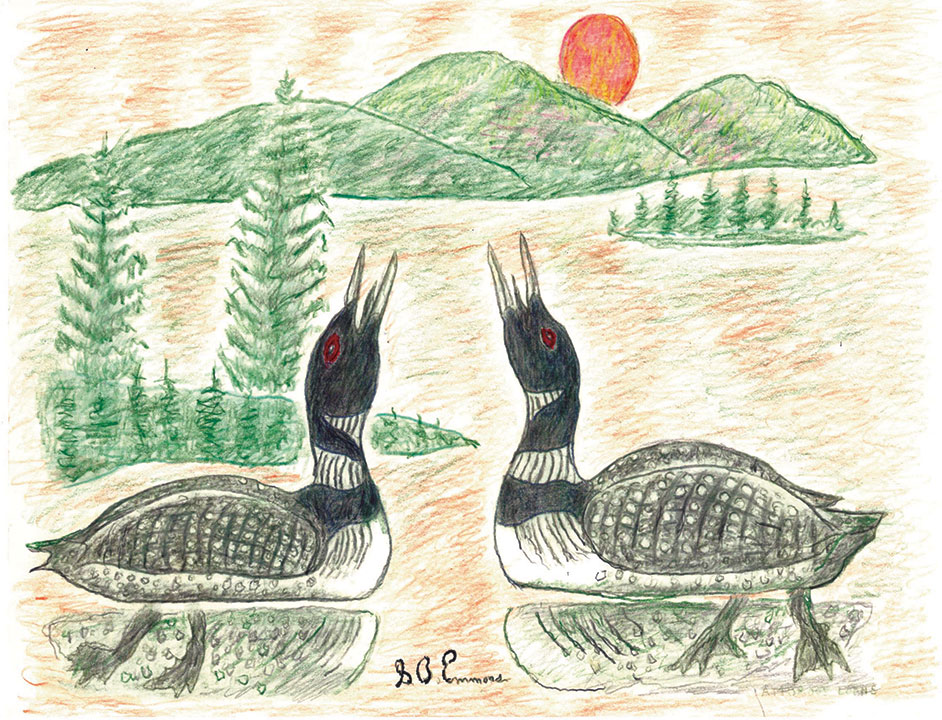If you are a bird watcher along the coastline of Buzzards Bay, loons may still appear coming in from the ocean where they spent the winter.
They started inland in spring when warmer water and prevailing onshore breeze pointed them northward in the direction of the Atlantic Flyway along with other sea bird migrations. They might then be seen and heard flying about 20 feet above the water at a speed of about 30 miles per hour. They often may land to rest for the night, but are not easy to recognize in their pale salty plumage to camouflage in a freezing environment. After their long journey beyond the reaches where the headlands of Massachusetts take them past Cape Ann, they soon must turn inland towards the northern lake country.
As they pass overcrowded cities and towns with factory smokestacks clouding the air and long lines of cars along thruways belching carbon monoxide, they probably fly higher to a quarter-mile up, and as fast as 60 miles per hour.
They do not assume any formation such as the “V” as with Canada geese, but call to each other, particularly when up ahead over the horizon appear the endless expanses of water in the White Mountains of New Hampshire. The largest promise of migration is the vision of Lake Winnipesaukee, an Indian name for “smile of the great spirit,” a welcoming human image of appreciation for migrants. The lake is also the headquarters of the Loon Preservation Committee. It annually distributes loon nesting platforms to make them feel at home once they are there.
The male usually selects the nesting site. Because their legs are so far back in their body, like their reptilian ancestors, they cannot stand or walk on land; it must be at the edge of water to be approached underwater. Both the male and female help furnish the nest, hatch, and guard one or two chicks who are born precocial, already covered with down, and able to swim the same day.
In the first two weeks, the iconic spectacle of back-riding may occupy 65 percent of their time. If approached by intruders to this family scene of security, the father will rise up in stature on the water with a ferocious beating of wings, thrashing the water with a territorial display while loudly yodeling an irate warning to scare anyone and everyone away. It makes a lasting impression when you have been close enough to cause the commotion called a Tremolo.
Loon occupancy to rear their young is an excellent, bellwether indicator of crystal-clear, pristine water quality to see prey far down at great depths for ample food supply to satisfy their needs. Both parents are seasoned divers and anglers propelled by active feet to shoot through the water like a torpedo or turn on a dime in direction by coursing wing movements. They also have solid bones for submerging with waterproof plumage, permitting them to drop their heads far enough underwater while swimming along the surface to scan far down for fish. They are able to drop out of sight completely for some length of time, only to resurface far away in a different direction, to mislead onlookers with predatory intent. They typically stay close to shore, able to disappear from sight, just around the corner of an island.
The loons’ survival instincts and evasive behavior down through the ages made it one of the oldest species on earth. Estimated by fossils of stratified lake-bottom pages in almost endless time, they are estimated to be billions of years old.
The uncanny spirit and mysterious evolution of this almost paranormal clairvoyance to live through the ages and harsh cataclysms can be heard in the wail of loons to mourn the hazards of survival. The wail is often a call from one Loon to locate another, or from one that has somehow lost its mate. Henry David Thoreau at Walden Pond described it as the most unearthly sound he had ever heard. As the midsummer sun goes down across the lake-side wilderness, the loon’s incredible annual migration is still only halfway complete. What lies ahead is the journey back again, to complete the unbroken chain of survival from the past into the future.
By George B. Emmons
